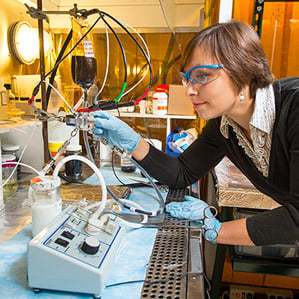A Battery with Liquid Electrodes Can Be Recharged or Refilled
A new kind of battery stores energy in what researchers are calling “rechargeable fuel”—electrodes in liquid form. The result can be either recharged like a conventional battery or replaced by pumping in new fuel like gasoline.

The materials could theoretically allow an electric car to travel 500 miles on a charge, five times farther than most electric vehicles can now, say the researchers developing the technology, who are based at Argonne National Laboratory and the Illinois Institute of Technology. Replacing them at a fueling station would take just a few minutes. In contrast, even the fastest charging stations for conventional batteries take an hour to provide a full charge.
Limited driving range and long recharging times are two of the biggest challenges for electric cars. Liquid battery electrodes could allow longer range by increasing the amount of energy battery packs can store, and because fewer non-energy-storing components would be needed, it could also make them cheaper.
Batteries that use liquid electrodes could also be safer than conventional ones, says Ping Liu, a program manager at the Advanced Research Projects Agency for Energy, which is funding the work. Positive and negative electrode materials would be stored in separate tanks, rather than inside the same battery cell as in conventional batteries. This could prevent the short circuits and overheating that can cause lithium-ion batteries to catch fire.
Rechargeable fuels are at an early stage, but ARPA-E has deemed them promising, announcing funding for four groups that are developing the technology. In addition to the Illinois project, it is backing projects at GE, the National Renewable Energy Laboratory, and 24M, an MIT spinoff.
The Illinois researchers have so far demonstrated a small “half-cell” battery that uses one fluid electrode and one solid one. For their $3.4 million ARPA-E-funded project, which started last month, they plan to build a prototype that uses liquids for both the positive and negative electrodes. This battery should store one kilowatt-hour of energy, enough for a few miles of driving.
In conventional electric-car batteries, as much as 75 percent of the material inside a battery pack consists of components that don’t store energy—cell packaging, sensors, electrical connections, cooling systems, and so on. With fluid energy storage, at least in theory, much of that material can be eliminated, decreasing the size and cost of battery packs.
The key is separating the energy-storing materials from the structures used to extract that energy and create electrical current. In a conventional battery, every layer of electrode material is paired with a sheet of foil and a plastic membrane that allow electrons and ions to flow, creating electrical current. If you want to store more energy, you need to add more layers of foil and plastic, too.
In the new battery, the fluid electrodes would be stored in tanks and pumped through a relatively small device to interact and generate electricity. Increasing energy storage would just be a matter of making the storage tanks bigger; the device where electricity is generated could stay the same size. The larger the tanks, the less of the total volume the energy-generating device would take up.
Fluid electrodes have been around for a while—for example, as part of devices called flow batteries—but they typically store energy in a dilute solution that requires too much volume to be used in a car. Some batteries have molten electrodes that are better suited for stationary applications (see “Ambri’s Better Battery”). Each of the ARPA-E projects aims to find ways to increase the energy density of the liquids by an order of magnitude. The MIT spinoff 24M is a pioneer in this area, having shown that it’s possible to suspend high concentrations of conventional, energy-dense electrode powders in a liquid and extract energy from them (see “A Car Battery at Half the Price”). The main challenge is achieving high enough electrical conductivity for a practical battery.
The Illinois researchers have a similar approach. They emphasize the use of nanoscale powders that can be suspended in very high concentrations and still flow easily, thanks to the peculiar properties of particles at such a small scale. They’ve also developed a new way of extracting electrical current from the particles, and they hope this will allow them to increase conductivity. The details are secret until they finish filing patents.
Liquid electrode batteries do have some potential drawbacks. Nanoparticles can degrade quickly, and the researchers have only begun to design the entire system. They need to design a way to pump the materials efficiently and manufacture the battery cheaply. And recharging cars by refilling the tanks with new material would require installing new infrastructure, which can be expensive.
Meanwhile, conventional batteries continue to get cheaper, and improved technology is making them faster to recharge (see “How Tesla Is Driving Electric Car Innovation” and “Forget Battery Swapping: Tesla Aims to Charge Electric Cars in Five Minutes”).
Deep Dive
Climate change and energy
The problem with plug-in hybrids? Their drivers.
Plug-in hybrids are often sold as a transition to EVs, but new data from Europe shows we’re still underestimating the emissions they produce.
Harvard has halted its long-planned atmospheric geoengineering experiment
The decision follows years of controversy and the departure of one of the program’s key researchers.
Why hydrogen is losing the race to power cleaner cars
Batteries are dominating zero-emissions vehicles, and the fuel has better uses elsewhere.
Decarbonizing production of energy is a quick win
Clean technologies, including carbon management platforms, enable the global energy industry to play a crucial role in the transition to net zero.
Stay connected
Get the latest updates from
MIT Technology Review
Discover special offers, top stories, upcoming events, and more.